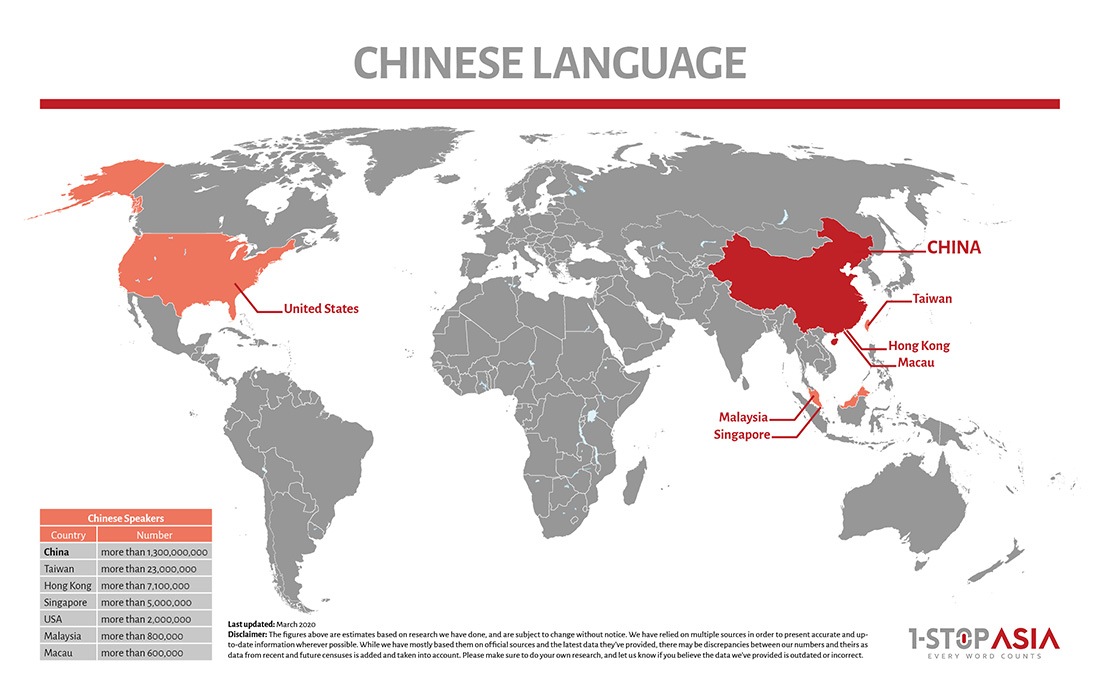Chinese Language
Reach 1.5B Chinese Speakers with Expert Translation Services
“Chinese” usually refers to Mandarin but it also includes other major dialects such as Cantonese, Minnan (Taiwanese), and Hakka
Chinese is the world’s most spoken language, making Chinese translation one of the most demanded services in the localization industry. Over a billion people speak it as their first language, so it’s no surprise that businesses are eager to communicate in Chinese.
Thanks to our years of experience and a skilled in-house team, we’ve streamlined our Chinese translation services to be quick, easy, and accurate, helping you provide exceptional translations to your clients, saving time and ensuring results.
You feel it is high time you focus on what matters most - your clients? We can assist.
Why Professional Chinese Translation Requires Expertise?
The Written Language
Chinese translation varies by context and is not universally applicable. With multiple writing systems, dialects, and cultural variations, it takes specialized knowledge to get it right.
Simplified vs. Traditional Chinese
There are two main writing systems: Simplified Chinese, used mainly in mainland China, and Traditional Chinese, common in Taiwan and Hong Kong. Simplified characters are more streamlined, while Traditional characters preserve the original, more complex forms. Native readers of Traditional Chinese can often understand Simplified Chinese but the reverse isn’t always true.
Regional Nuances and Honorifics
Chinese is challenging to translate due to its many dialects and regional differences. For example, there are two ways to say “you”: “您” for formal situations, and “你” for casual and getting such details right is the key to sounding more natural.
Localization by Market
Traditional Chinese content needs to be translated carefully for specific regions like Hong Kong and Taiwan where word choice, phrasing, and tone can vary significantly. In places like North America where audiences often include both newer immigrants from mainland China and older generations from Taiwan or Hong Kong, offering both versions is often the most effective approach.
Choosing the Right Variant
There are a variety of Chinese translations – Mandarin or Cantonese, Simplified or Traditional. Each project comes with its own set of details and that’s why we recommend reaching out to our team directly to guide you through the options and help you choose the best approach for your specific needs.
The Spoken Language
Chinese is a tonal language which means pitch plays a crucial role in a word’s meaning. Most spoken dialects use tones – some northern ones have not more than three, while some southern ones have six or even twelve, depending on classification. An exception is Shanghainese, which uses a two-tone pitch-accent system, similar to modern Japanese.
A small change in tone can lead to a completely different message. For example, wǒ xiǎng wèn nǐ (with a falling tone on “wèn”) means “I want to ask you,” while wǒ xiǎng wěn nǐ (with a rising-falling tone on “wěn”) means “I want to kiss you.”
Get exclusive insights into the world of translation, localization, and the language industry.
How We Can Support You
Native Translators with Local Expertise
At 1-StopAsia we are both globally connected and deeply rooted in China.This allows us to help our clients truly connect with their target audience by tailoring the language, writing style, and tone to perfectly match the type of Chinese they need. We don’t just translate - we make sure your message speaks directly to your customers.
25 Years of Expertise
Through our 25 years in the industry, we’ve built a team of professionals who truly understand the challenges of translation workflows. They quickly assess clients’ needs and provide professional translation services to match them. Always ready to assist with your inquiries, they also save you time while delivering you accurate translations.

